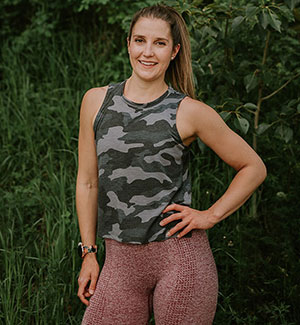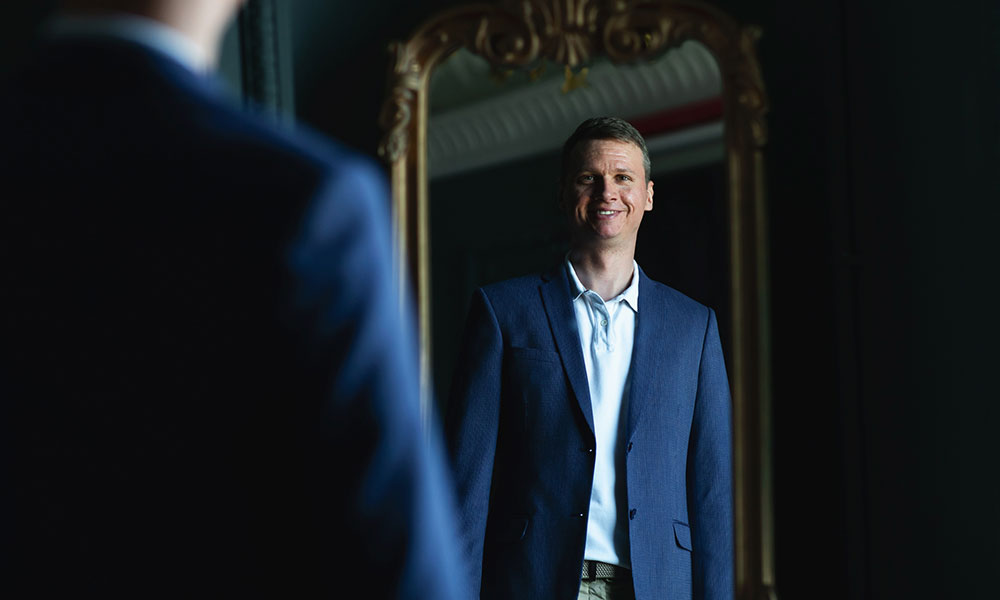Personal Fitness Trainer grads highlight better indicators of health
When Shawn Raymond (Personal Fitness Trainer ’17) was a trainer at another gym, management told him weight check-ins should be part of tracking client progress.
“I made none of my clients do it because I wanted them to feel the success,” says Raymond, now the owner of SRTraining, in Leduc. He didn’t want their gains to be defined or undermined by a number on a scale.
Falon Fleming (Personal Fitness Trainer ’15), owner of Falon Fuelled Fitness, is of similar mind. “I have no idea what I weigh,” she says. “I think the last time I got weighed was at the doctor, and I tuned him out.”
But the trainers may be among a minority that has learned to separate weight and wellness. A 2021 report pegged the global market for weight loss products and services at US$254.9 billion, and growing to $377.3 billion by 2026.
Undoubtedly, the common bathroom scale is helping to spur on that spending – something Raymond and Fleming want to see change.
“We really need to step away from the scale. It's making us feel negative toward ourselves when it's our sole focus,” says Fleming. “There are so many other things that we can use as an indicator of health.”
To help move the needle toward a better path to wellness, we talked to Fleming and Raymond about why we fixate on a number, healthier measures of success, and how we can stop being weighed down by a limited perspective on fitness.
Redefining weight
 Raymond reminds clients that the human body is a composite structure, and that the number on the scale doesn’t reflect that.
Raymond reminds clients that the human body is a composite structure, and that the number on the scale doesn’t reflect that.
“Your body is not just fat,” he says. “It is the skeletal system, it is the muscular system. There's a large portion of your weight that is determined by how much water you drink.”
Ironically, Raymond will often use a scale to reinforce that, and help redefine the concept of “weight” for his clients.
Among his tools is a smart scale that sends a painless electrical current up through the feet to assess body composition.
It allows Raymond to demonstrate improvements such as muscle development, decreases in visceral fat that clings to organs and inhibits function, water consumption and more – even if overall body mass remains more or less the same.
Why we focus on weight
 In part, we focus on our own weight because of what we see in others, say the trainers. We aspire, but in doing so we may also judge ourselves.
In part, we focus on our own weight because of what we see in others, say the trainers. We aspire, but in doing so we may also judge ourselves.
“The last two, three decades, in my opinion, have been toxic for the environment of self-love,” says Raymond.
Social media and magazines were dominated by “skinny models,” he says, and by messages of “here's a diet, here’s the life you want, you’ll be healthier if you do these things.”
While he believes that’s changing, damage has been done.
“It takes a lot of time to unlearn that ‘diet culture,’” says Fleming. And she feels that her own industry hasn’t helped much either. As evidence, she points to the Instagram hashtag #fitspiration, where influencers, including some trainers, distort body image in a way that might have some viewers heading for their scales.
“[Look at] the transformation photos, right?” says Fleming. “Here's my before, here's my after – this is what I'm aspiring to be, but what I was before was not accepted.”
Redefining success

Sometimes, those influences are expressed by clients as a kind of faulty nostalgia.
When Fleming asks for their take on their best selves, “It's like, ‘I'm 20 pounds lighter, I look thinner.’” What she’d rather hear is, “I'm able to be functional. I live a longer life, because I'm stronger.”
Raymond also hears unrealistic goals. Right or wrong, clients tend to see their younger, lighter selves as happier. “If I can get back to that weight,” he’s told, “I'm going to feel like that again.” It’s unlikely to happen, and happiness isn’t guaranteed even if it does.
The trainers see reshaping goals as essential to relieving negative relationships with the scale. Rather than allow clients to focus on one number that tells only part of the story, Fleming points them toward other metrics, such as “different muscular-skeletal assessments – things that measure strength, like grip, or a certain amount of reps with a certain amount of resistance.
“Success,” she stresses, “can be your ability to do something you couldn't do before.”
Driving toward acceptance

Ideally, says Fleming, we’re all aiming for equilibrium, a maintenance phase in which we feel our healthiest, not our thinnest. “We can still make progress in our strength [but] the scale isn’t going to change very much,” she says.
Fleming frequently works with older adults. She often finds their attitudes toward fitness and wellness to be exemplary. They know, “My body's changing, I'm not going to be able to do what I did when I was 30 or 40,” she says. Their goals adapt, focusing on activities such as being able to play with grandchildren or to continue going for hikes.
Raymond sees great potential for contentment in reaching such goals, rather than in chasing a number that can only get so small. His own sense of success as a trainer is to lead a client to something more than just physical well-being, and to a more holistic sense of accomplishment.
“My happiness comes from instilling the feeling of ‘I am enough’ in my clients,” Raymond says. He wants their satisfaction to come from an ability to do things that might once have seemed like “the hard things in life.”
Sometimes, that includes reevaluating their own sense of worth. For that, Raymond tries to help them put in the work that will give them confidence and courage, “and help them break down self-limiting beliefs so that they can learn to love themselves – outside of what the scale tells them.”